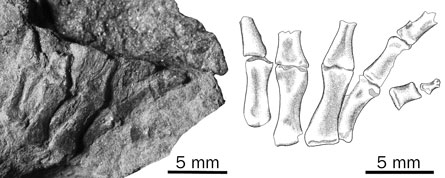Early toehold on land
A five-toed fossil now holds the record for smallest, oldest foot ever found
Share this:
- Share via email (Opens in new window) Email
- Click to share on Facebook (Opens in new window) Facebook
- Click to share on X (Opens in new window) X
- Click to share on Pinterest (Opens in new window) Pinterest
- Click to share on Reddit (Opens in new window) Reddit
- Share to Google Classroom (Opens in new window) Google Classroom
- Click to print (Opens in new window) Print

Life on Earth began in the water. But at some point in ancient history, animals dried off and started living on land, too. Scientists can’t travel back in time — yet — to see when it happened, but they can get hints from fossils. Those are the remains of animals, plants and other organisms preserved in rock. Fossils are a window on the past, and they can help us understand how modern life began.
The discovery of an ancient, five-toed fossil offers new clues on when four-legged critters started walking on dry ground. The fossil is only about as wide as a marble, and researchers don’t know what the animal looked like. However, the footprint it’s older than any other fossil from a similar animal. It remained buried in Scottish ground for more than 345 million years — far longer than the country of Scotland has existed.
“This is the earliest and smallest foot ever found with five digits,” Jennifer Clack told Science News. Clack, a paleontologist at the University of Cambridge in England, described the fossil with her colleagues in a recent paper. “It tells us that terrestrialization occurred much earlier than we had a hint of before.”
Paleontologists study fossils and rocks to understand prehistoric life. They use the word “terrestrialization” to describe how sea-dwelling species adapted, or changed over many millions of years, to live on land. Clack says that a five-toed foot can hold some weight and help an animal get around on land.
The creature lived in the aftermath of a dramatic event in Earth’s history. About 360 million years ago, more than half of all vertebrate species on the planet vanished during a massive extinction. Most of those vertebrates — animals with backbones — were either fish or fish like creatures that were just adapting to life out of the water.
Scientists don’t know what happened right after the big die-off. But within 15 million years, plenty of creatures had begun living on land. Near the Scottish site where the fossil foot emerged, scientists found the jawbone of another creature, one that was probably more than 2 meters (6 feet) long.
Michael Coates, a paleontologist at the University of Chicago who did not work on the new study, told Science News that life after the mass extinction was surprisingly different from what came before.
“We’re seeing a different cast of characters showing up,” he said.
POWER WORDS (adapted from the New Oxford American Dictionary)
evolution The process by which species adapt and change over time.
extinction The state or process of a species, family or larger group of organisms ceasing to exist.
fossil The remains or impressions of a prehistoric organism preserved in petrified form or as a mold or cast in rock.
paleontology The branch of science concerned with fossil animals and plants.
vertebrate An animal that has a long backbone or spinal column. Vertebrates include mammals, birds, reptiles, amphibians and fish.







